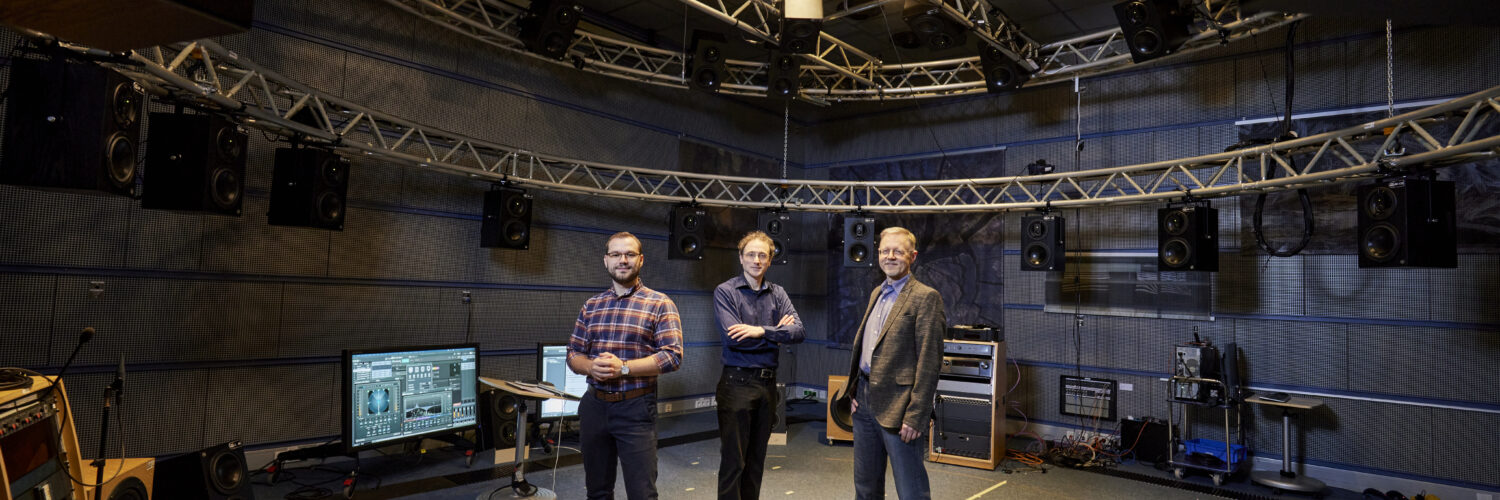MPEG-H Audio delivers customized listening experiences in 3D.
Whether streaming music and movies, watching TV or in the car: The MPEG-H Audio system makes it possible to fully immerse yourself in soundscapes and adjust them to your own preferences. Three researchers from the Fraunhofer Institute for Integrated Circuits IIS — representing a large team — are being awarded the Joseph von Fraunhofer Prize 2023 for this development. The prize is awarded to employees of the Fraunhofer-Gesellschaft for their outstanding scientific achievements in solving application-related problems.
Turn up the volume on the TV movie dialogue, lower the background noise? Select your favorite sport commentator at the touch of a button? Or turn the drums down a bit while listening to music? The MPEG-H Audio system from the Fraunhofer IIS makes it easy to personalize 3D sound. For the development of the system, Harald Fuchs, Dr. Achim Kuntz, and Adrian Murtaza — representing the team — will be awarded the Joseph von Fraunhofer Prize 2023.
Metadata for individual sound experiences
The MPEG-H Audio system brings the three-dimensional world of sound to more and more playback devices. The process used for this clearly distinguishes the technology from Fraunhofer IIS from other 3D sound systems: Instead of using only classic audio tracks, the format works with audio objects. Such an object, for example a singing bird, is assigned properties such as position and volume through metadata. They are used to determine what happens to the sound: The birdsong moves in three-dimensional space, becoming louder and softer. All this information is sent to the playback system, where it is combined with information about the playback environment. Only now are the loudspeaker signals created — in contrast to usual formats such as 5.1 or 7.1.
The new approach of describing audio objects through metadata also enables content to be personalized: choosing between different languages, making movie dialogues louder and thus more understandable, positioning the voice of the sports commentator freely in the room, and hearing more or less audience sound at live events.
MPEG-H Audio: Innovative system from production to playback
The Fraunhofer IIS team has developed a complete system that covers the entire chain from sound production to transmission and playback. And not just in the broadcast chain of television productions: “We want to make sure that every production, transmission, and playback situation is covered by MPEG-H Audio,” Kuntz explains. “The MPEG-H Audio system therefore goes far beyond a mere audio codec: It includes production tools, file and transmission formats, and innovative playback methods as well as software solutions for integrators.” Another example of one of the many developments around MPEG-H Audio is the immersive object-based music format 360 Reality Audio from the electronics company Sony. It can already be found on many streaming services — an album produced with this technology even won the Grammy for Best Immersive Album in 2023.
The end of the test phase
Developing such a comprehensive audio system is only possible with a large team: At peak times, up to a hundred people were working simultaneously on the project, which started back in 2012 — currently there are still around 50 employees. In addition, international support was important. Industry and technology partners around the world helped make MPEG-H Audio fit for use in a wide variety of environments. Brazil, for example: After large-scale comparative tests, the country decided in December 2021 to use the new technology as the mandatory audio standard for its new TV infrastructure. MPEG-H Audio has also been tested a number of times in Europe. In short, the MPEG-H Audio system is the world’s only open standardized system for transmitting the next generation of audio formats.
About the Joseph von Fraunhofer Prize
Since 1978, the Fraunhofer-Gesellschaft has awarded annual prizes to its employees for outstanding scientific achievements that solve practical problems. This year, three prizes worth 50,000 euros each will be awarded to research groups from different institutes.

